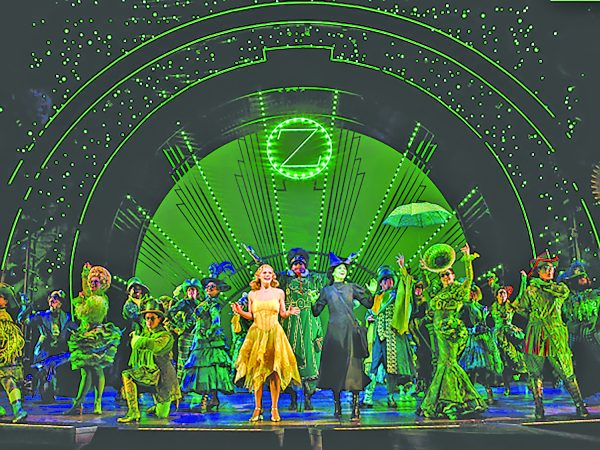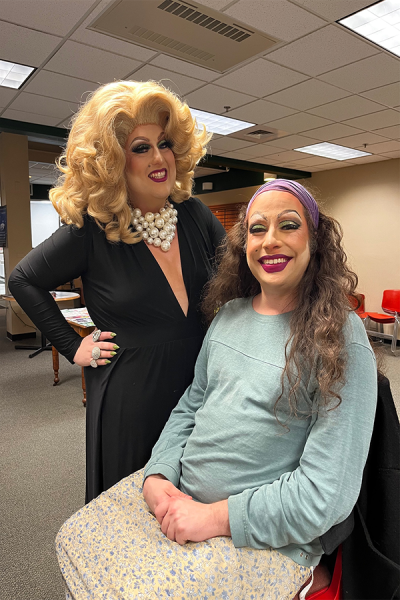“Mr. Burns” perplexes despite valiant cast efforts
A hush falls over the crowd as four actors march onto the stage, silently taking a seat in dilapidated furniture. The dappled lighting casts star-like shapes across the actors’ faces, the ceiling, and the rest of the set as they begin an almost-stinted conversation about a Simpsons episode that they all barely remember.
It’s a bit like watching four violinists sight-read sheet music, coming to life with whining melodies that fall and crescendo only to stop abruptly when they forget something.
Though the actors are expressive, and their timing with one another is impeccable, you can almost hear the question marks forming over the audience members’ heads as they try desperately to understand the winding and seemingly arbitrary script.
“Mr. Burns” is a post-electric play, written by American playwright Anne Washburn, is supposedly set in a world where nuclear fallout has decimated much of the landscape, and completely annihilated our modern way of life. In order to cope with their situation, the main characters reminisce about many Simpson episodes, a common thread throughout the play.
In each of the three acts, the Simpsons take on a new role in this new society.
For better and for worse, the play came to the Dibden stage on Nov 8, with a cast of 12 students performing under the watchful eye of director Isaac Eddy, assistant professor of Performing Arts.
With such a small cast, usually it’s fairly easy to pinpoint the outstanding actors, but I was impressed across the board with each actor’s performance. Kyle Palmer, who played Gibson and Homer, was absolutely amazing in the first act.
He brought a calm demeanor to the stage and played the character as an even-keel type of guy. Alongside him was Amanda Rosalbo (Jenny and Marge), whose character tended to be a bit more manic and outgoing. I was impressed with how she maintained the level of high energy needed throughout the entire first two acts.
As we headed into the final act, we were really shown the breadth of both Emmett Erwin’s (Sam and Mr. Burns) and Kimmy Rose’s (Quincy, Bart, and Nelson) acting abilities.
Erwin was able to play a convincing villain, and while the play called for a cartoon type villain, he managed to play it up without it becoming too corny.
Meanwhile, Rose’s mournful song towards the end of act three nearly brought tears to my eyes as she lamented the loss of her family.
Unfortunately, had you not read the play prior to coming, you may have been completely lost throughout all three acts. The first act included many loose ends, such as the girl sitting in the shadows and giggling at seemingly random points.
My biggest problem with this? It was absolutely never addressed.
In the following act, she joined the rest of the crew and seemed to have a decently important role in their small group, running their live show and calling all the shots. In fact, many of the characters were offered no explanations, as if the playwright were simply throwing the script in your face suggesting that you figure it out.
Never before in my life have I uttered the words, “I really wish this had a narrator,” but, then again, I’ve never seen a play like “Mr. Burns.” You almost have to have both the script and Wikipedia page in your lap, as if you were reading Shakespeare.
After the final scene, it seemed the audience wasn’t truly sure if it was over or not. Even out in the lobby, everyone seemed to be waiting for someone to tell them what the hell was going on.
However, I can’t bear to fault the cast or crew throughout this experience. They did the absolute most with the strangely barren characters they were told to play, completely immersing themselves in the characters and producing more emotion than what the script could have possibly given them.
In the second act, they brightened the entire performance with a seemingly impromptu song mashup/ flashmob that had the audience wailing with laughter, practically in tears as the cast sang to many of our generation’s pop favorites. This was by far the highlight of the show, where you really saw the audience and cast finally connecting.
Behind the scenes, the lighting and sound crews were outstanding. The use of the blue, sporadic lighting, contrasting with the yellow stage lights created an eerie feeling that carried throughout the entire final act.
During intermission, I started to feel chills as the music began to play. I could hardly believe my eyes when I realized that students were the ones behind it, not a professional recording.
I could not be any more pleased with the crew of this show.
Would I ever go to see “Mr. Burns” again?
No, absolutely not.
However, I am impatiently awaiting Dibden’s next performance and hope to see some familiar faces back on the stage.







